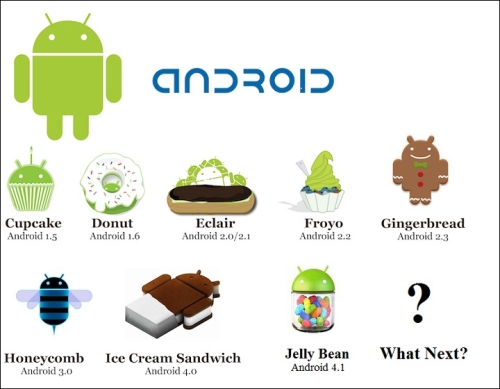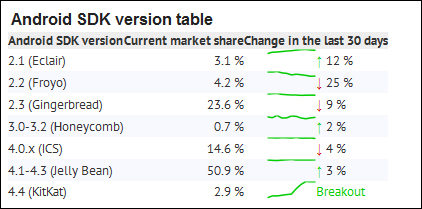Android is a Linux-based open source operating system, primarily targeted for touch screen mobiles and tablets. Andy Rubin, Rich Miner, Nick Sears, and Chris White founded the operating system in October 2003. The basic intention behind the idea of Android was to develop an operating system for digital content. This was because, at that time, mobiles were using Symbian and Windows Mobile as their operating systems.
Note
iPhone was released in June 2007 by Apple Inc. Android was released in November 2007 by Google Inc.
However, when they realized that there is not much of a market for devices such as cameras, they diverted their attention to mobile phones against Symbian and Windows Mobile. iPhone was not on the market then. Android Inc., a top brand for smart phone operating systems covering 75 percent of market share as of today in smartphones, was running secretly at that time. They revealed nothing to the market except that they were working on software for mobile phones. That same year, Rubin, the co-founder of Android, ran out of money, and his close friend, Steve Perlman, brought him $10,000 cash in an envelope.
In August 2005, Google Inc. acquired Android Inc., making it a subsidiary of Google Inc. The primary employees of Android stayed in Android Inc. after acquisition. Andy Rubin developed a mobile device platform powered by Linux Kernel. Handset makers and carriers were being promised a flexible and upgradeable operating system by Google. As Google was not releasing any news about Android in the media, rumors started to spread around. Speculations spreading around included Google is developing Google branded handsets and Google is defining cell phone prototypes and technical specifications. These speculations and rumors continued until December 2006.
Later, in November 2007, Open Handset Alliance revealed that their goal was to develop an open standard for mobile devices. Android was released as its first product; a mobile device platform built on Linux Kernel Version 2.6. Open Handset Alliance is a consortium of 65 companies involved in mobile space advocating open source standards for the mobile industry.
In October 2008, the very first commercially available phone deploying Android operating system was released by HTC, called HTC Dream. The following image shows HTC Dream. Since then Android is being upgraded. Google launched its nexus series in 2010.

HTC Dream, the First Android phone using Android Activity back stack
After the first appearance of Android OS in HTC Dream, it gained rapid popularity among consumers. Android is continuously being upgraded by Google. Each major release includes bug fixes from the last release and new features.
Android released its first version in September 2008 in the device HTC Hero. Android 1.1 was an update tweaking bugs and issues, with no major release. After Android 1.1, Android 1.5 named Cupcake, was released with features such as video uploading, text prediction, and so on. Android 1.6 Donut and Android 2.0/2.1 Éclair released at the end of 2009, followed by 2.1 in January 2010, introduced major updates such as Google Maps, enhanced photo video capabilities, Bluetooth, multi-touch support, live wallpapers, and more. In May 2010, Android 2.2 named as Frozen Yogurt, or Froyo, was the major release, adding support for Wi-Fi hotspot connectivity.
This version became very popular among developers, and is used to be the minimum API level for android apps. Android 2.3 Gingerbread, released in May 2010 introduced the Near Field Communication (NFC) capability, which allowed users to perform tasks such as mobile payments and data exchange. This version of Android became the most popular version among developers. Android 3.0/3.1 Honeycomb, was specially optimized for tablet devices, and more UI control for developers was a big plus. Android 4.0 Ice Cream Sandwich was released in October 2011. Since Android 3.0/3.1 was only for tablets, the Ice Cream Sandwich release overhauled the gap, and was supported by both mobile phones and tablets. The latest release of Android, Android 4.2 Jelly Bean further polished the UI, refined the software, among other improvements.
Note
Google started naming Android versions after sugar treats, in alphabetical order, after Android 1.1 version.
The following image shows all the versions in a visual format:

The following screenshot shows the current distribution (March 2013) of Android versions. It is clear from the screenshot that Android 2.3 Gingerbread is the most popular version, followed by Android Ice Cream 4.0:

Current distributions of Android versions



